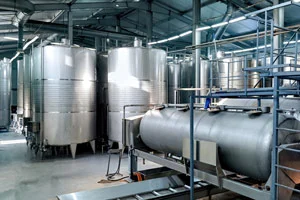Someone once said that wine is the only work of art you can drink. Just as no one would want to ruin a great painting, they wouldn’t want to spoil a good wine. This is why you should avoid certain mistakes when handling wine. In this article, we’ll show you how temperature affects wine conservation.
How does temperature affect wine conservation in oxidation reactions?
Wine oxidation processes are complex and depend on a large number of factors, but can be summarized as follows. Wine contains compounds that act as oxidation substrates and others as oxidants. Also, the rest of the compounds and conditions regulate the rate at which such reactions occur. Within this process, there are chain reactions that cause the oxidation of even more compounds, without the need for oxygen to be present.
Oxygen alone cannot oxidize most of the compounds in wine. In order to oxidize these compounds, a catalyst must perform an electron transfer. The main catalysts are Fe and Cu, which are able to transfer electrons to molecular oxygen, generating highly oxidizing radicals.
The oxidation chains are produced once these radicals are formed. In summary, the chain reaction would look like this:

As we’ve seen, the oxidation chain is complex, and actions should be taken to prevent these reactions in each of the phases. As experts in the sector, Agrovin recommends reading this guide so that you can perform this process correctly.
An increase in temperature increases the reaction rate, regardless of its nature. This is because higher temperatures increase the likelihood that the compounds involved in the reaction will be found in an active form. The reaction rate doubles for every 10ºC that the temperature increases. So, if we want to reduce the speed of oxidation reactions, wines must be kept at low temperatures and avoid the incorporation of oxygen at all times because at low temperatures, its solubility increases.
How does temperature affect microbiological growth?
Each microorganism has an optimal temperature range for its activity.
The microorganism Saccharomyces cerevisiae, for example, is inactive or has very low activity below 10–12 °C and shows maximum growth in grape must at around 35 °C. The presence of alcohol reduces the optimum temperature to 26–28 °C.
In contrast, Kloeckera is more active than Saccharomyces cerevisiae at temperatures of 4–10 °C, and is used during the cold maceration of must. Lactic bacteria require 16–18 °C to grow at a considerable rate. Acetic bacteria can persist at high temperatures, even in the presence of alcohol.
Therefore, preserving wines correctly at low temperatures is an effective strategy for reducing the growth of microorganism contamination, both in must and wine. Low temperatures, however, slow the growth and activity of microorganisms, but do not inactivate or eliminate them from the system. A subsequent increase in temperature will restart the contamination process.
Because a subsequent increase in temperature will restart the contamination process, wines must undergo microbiological control, and it is important to take action when populations reach a certain level. As experts in the sector, Agrovin recommends using Microstab Protect,, a product that:
- Substantially reduces or eliminates Brettanomyces populations
- Effectively reduces the populations of yeasts and lactic bacteria
- Has an antioxidant effect and protects against oxidation
- Deactivates oxidation catalysts
- Reduces metal content (Fe and Cu)
If you’d like more information or have any questions, please feel free to contact us.

